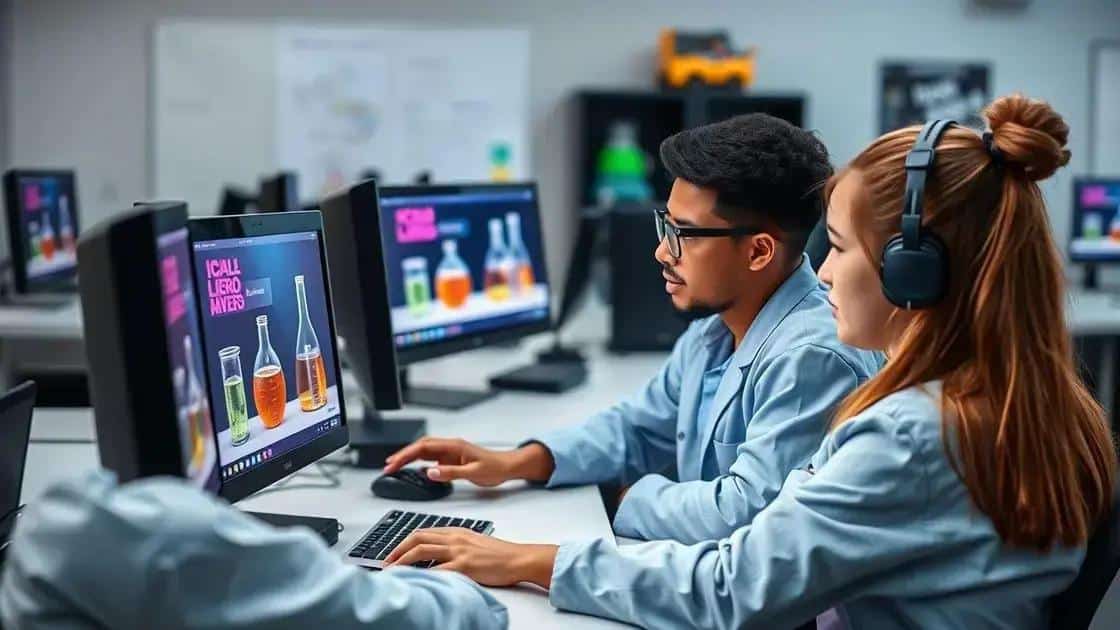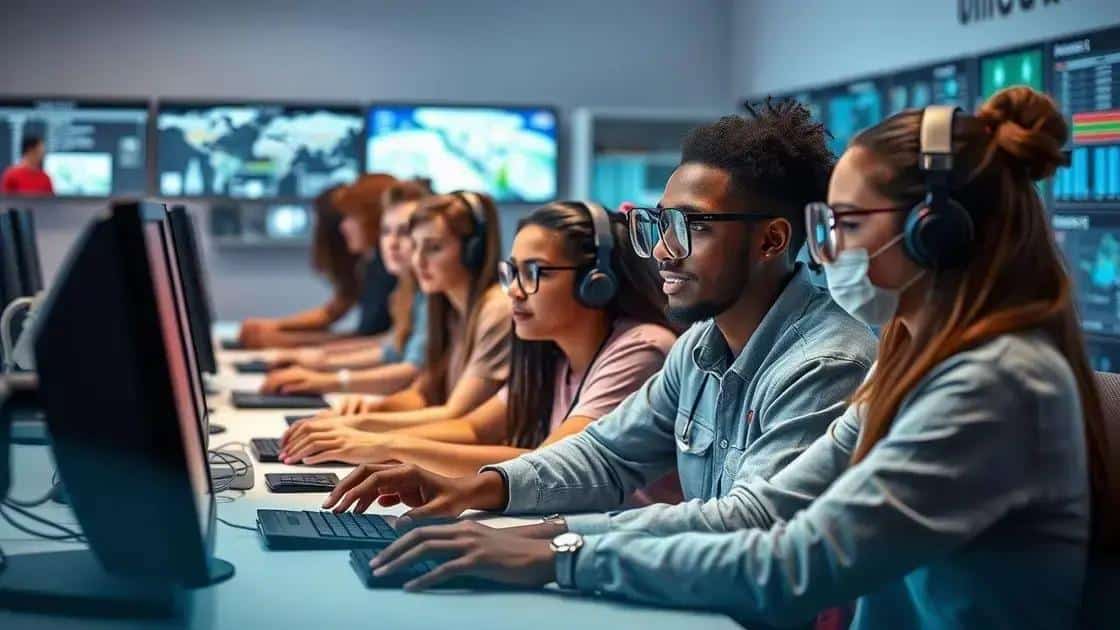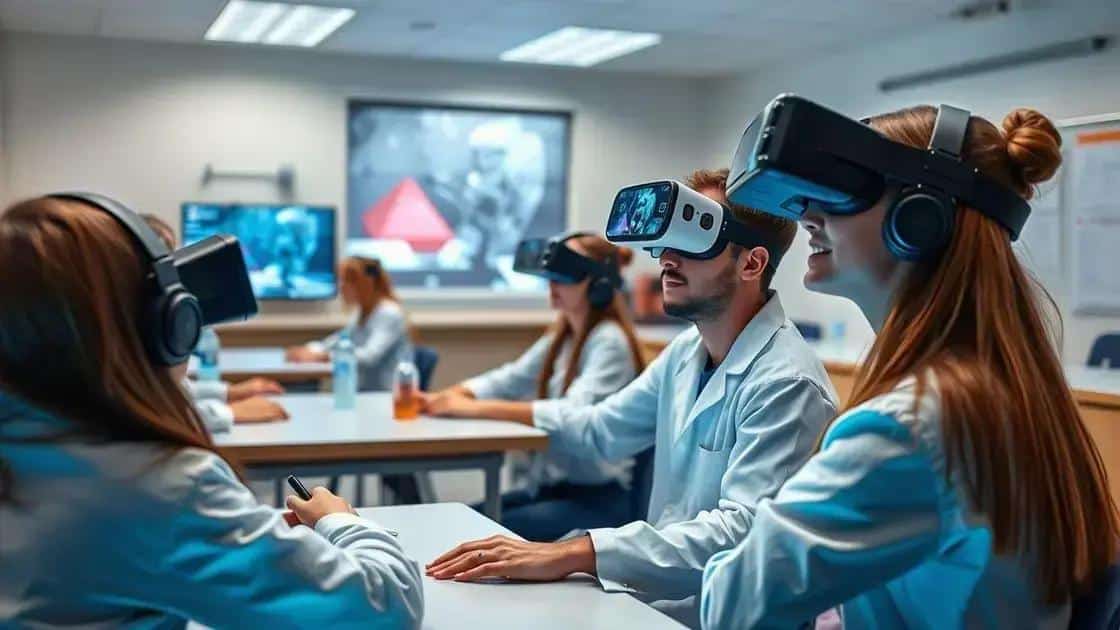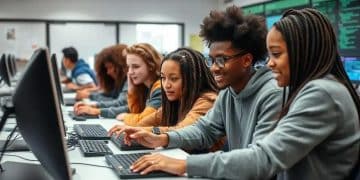Insights on virtual lab simulations that enhance learning

Virtual lab simulations enhance education by providing interactive and immersive learning experiences, improving accessibility, engagement, and understanding of complex scientific concepts through advanced technologies like AR and AI.
Insights on virtual lab simulations reveal how these innovative tools are reshaping education. Imagine students conducting experiments without the constraints of a physical lab. Curious about how this impacts learning outcomes? Let’s dive in!
Understanding the significance of virtual lab simulations
Understanding the significance of virtual lab simulations is essential in today’s educational landscape. These tools allow students to engage in practical learning experiences without the limitations of physical labs. Imagine a classroom where students can conduct experiments safely and repeatedly, enhancing their grasp of complex concepts.
Benefits of Virtual Lab Simulations
Virtual lab simulations offer several advantages. They provide a hands-on experience while promoting safety and accessibility. Students can explore subjects like chemistry, physics, and biology in a controlled environment.
- Safety: No risk of accidents or hazardous materials.
- Accessibility: Available to students regardless of location.
- Cost-effective: Reduces the expenses of maintaining physical labs.
- Engagement: Interactive formats that keep students involved.
These features make virtual lab simulations a valuable learning tool. Moreover, they cater to various learning styles, allowing students to learn at their own pace. For instance, visual learners can benefit from seeing experiments in action, while kinesthetic learners can manipulate virtual instruments.Technology is continually evolving, making these simulations more realistic and effective. With advancements in graphics and interactivity, students can now experience lifelike scenarios that bring theory to practice.
Real-World Applications
Understanding the applications of virtual labs helps in grasping their importance. Many educational institutions use these simulations to prepare students for real-world challenges. Fields such as medicine, engineering, and environmental science benefit notably from these tools.
By incorporating virtual lab simulations into curricula, educators can ensure that students grasp fundamental principles while experiencing content relevant to their future careers. For example, medical students practice surgeries in virtual environments, allowing them to make mistakes safely and learn from them.
In conclusion, the significance of virtual lab simulations cannot be overstated. They provide enriching experiences, promote safety, and prepare students for future success.
Key benefits of using virtual lab simulations

There are many key benefits of using virtual lab simulations in education. These tools provide students with exciting opportunities to learn and practice skills in a safe environment. Students can explore complex scientific concepts without the risks associated with physical experiments.
Enhanced Learning Experience
One major benefit is that virtual lab simulations create an interactive and engaging learning experience. They allow students to visualize processes and experiments that may be challenging to understand through traditional methods. By combining visual technology with scientific principles, students grasp concepts more quickly.
- Accessibility: Students can access labs from anywhere, breaking geographical barriers.
- Flexibility: Learning at their own pace helps students absorb information better.
- Immediate Feedback: Virtual simulations often provide instant results, aiding in understanding.
Additionally, these simulations cater to different learning styles. Whether a student learns best by seeing or doing, virtual lab simulations can adapt to meet their needs. This adaptability fosters a personalized educational experience.
Cost-Effectiveness
Another significant benefit is the cost-effectiveness of virtual lab simulations. Physical labs require expensive equipment and maintenance. In contrast, virtual labs provide a budget-friendly alternative. Schools can allocate resources more efficiently, ensuring that students receive quality education without overspending.
Moreover, they eliminate the costs associated with materials that would otherwise be used in a traditional lab setting. Virtual simulations allow unlimited trials, giving students multiple chances to learn from their mistakes.
The integration of virtual lab simulations creates a more inclusive and effective learning environment. With the ability to overcome physical limitations, students can explore scientific concepts richly and deeply. Ensuring that each student has access to these tools is essential for enhancing education today.
How to effectively implement virtual lab simulations
Implementing virtual lab simulations effectively can transform the learning environment for students. To start, it’s essential to choose the right software that aligns with the curriculum. Many simulations are available, so selecting one that offers comprehensive features tailored to your educational goals is key.
Steps for Implementation
The process begins with training educators. Teachers need to be comfortable with the technology to guide students effectively. Workshops or online tutorials can provide valuable training on using virtual labs to their fullest potential.
- Evaluate Existing Curriculum: Determine where virtual lab simulations can fit in and enhance learning.
- Set Clear Objectives: Define what you want students to achieve through these simulations.
- Integrate With Lessons: Incorporate simulations into existing lesson plans for a seamless experience.
- Gather Feedback: Encourage students to share their experiences for continuous improvement.
Furthermore, it’s important to create an engaging environment. Schools can host demonstrations to showcase how virtual lab simulations work and spark interest among students. This approach helps students understand the value of simulations in practical applications.
Technology Considerations
Another aspect of effective implementation involves ensuring that students have access to the necessary technology. This means providing adequate computers and internet connections. Schools must evaluate their resources and capabilities to support virtual labs.
Additionally, collaboration among educators is vital. Teachers can share techniques and best practices, enhancing the overall experience. By working together, they can refine how virtual lab simulations are used in the classroom.
Finally, monitoring progress through assessments can help gauge the effectiveness of simulations. Using quizzes or projects post-simulation can reinforce learning and confirm that students are meeting established objectives.
Future trends in virtual lab simulations

The future trends in virtual lab simulations are exciting and offer numerous possibilities for enhancing education. As technology continues to evolve, these simulations are becoming more interactive and immersive. Students can look forward to experiences that closely mimic real-life laboratory conditions, making learning more effective.
Emerging Technologies
One major trend is the integration of augmented reality (AR) and virtual reality (VR) into virtual lab simulations. These technologies allow students to engage with experiments in a 3D environment, providing a more tactile experience than traditional simulations. With AR and VR, students can explore molecular structures in real-time, improving their understanding of complex scientific concepts.
- Increased immersion: Students feel they are part of the experiment.
- Enhanced collaboration: Group activities can simulate real lab teamwork.
- Realistic scenarios: Users can carry out experiments that resemble actual lab situations.
Additionally, the use of artificial intelligence will play a significant role in personalizing the learning experience. AIs can analyze how students interact with simulations and offer tailored feedback. This feature helps address individual learning needs and strengthens their grasp of topics.
Accessibility and Inclusivity
Another future trend focuses on making virtual lab simulations more accessible. Developers are creating platforms that require less processing power, allowing more students to access these tools, even on low-spec devices. Accessibility is crucial in ensuring that all students, regardless of their economic background, can benefit from modern educational technologies.
Furthermore, integrating diverse scenarios into simulations will enrich the educational experience. For instance, scenarios that demonstrate environmental issues or social justice in scientific research can help students see the relevance of their studies in real-world contexts.
As educational methods continue to progress, the trend of incorporating gamification into virtual lab simulations will become more prominent. Elements like points, levels, and challenges can make learning more engaging and motivating for students.
In conclusion, virtual lab simulations revolutionize educational experiences by making learning more interactive and accessible. These innovative tools offer numerous benefits, including enhanced engagement, cost-effectiveness, and personalized learning opportunities. As technology continues to develop, trends such as augmented reality and artificial intelligence will further enrich the potential of virtual labs in classrooms. With these advancements, students can look forward to exciting and effective ways to grasp complex scientific concepts, preparing them well for future careers in science and technology.
FAQ – Frequently Asked Questions about Virtual Lab Simulations
What are virtual lab simulations?
Virtual lab simulations are interactive online tools that allow students to conduct experiments in a safe and controlled digital environment.
How can virtual lab simulations enhance learning?
They provide hands-on experiences, engage students in complex concepts, and accommodate various learning styles, improving overall understanding.
What technology is used in virtual lab simulations?
Many simulations incorporate augmented reality (AR), virtual reality (VR), and artificial intelligence (AI) to create immersive learning experiences.
Are virtual lab simulations cost-effective?
Yes, they reduce the need for physical lab equipment and materials, making science education more accessible without compromising quality.






